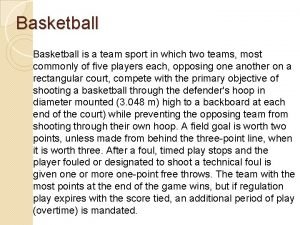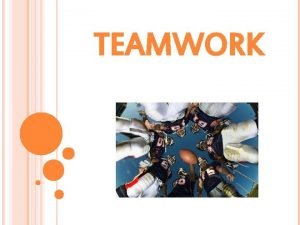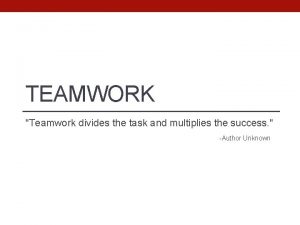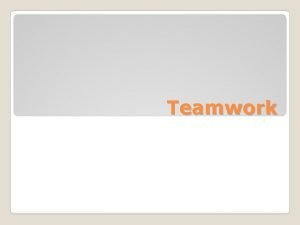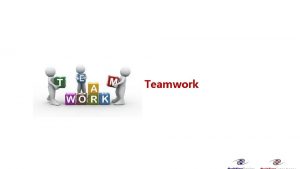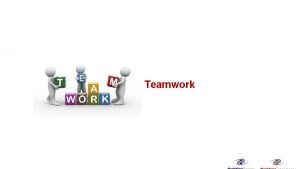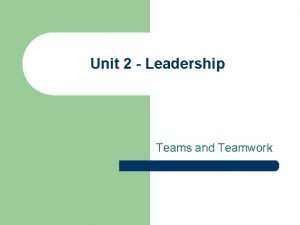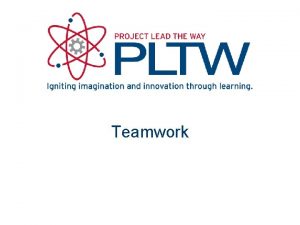Chapter 3 Teams teamwork and team dynamics Jane

















- Slides: 17

Chapter 3 Teams, teamwork and team dynamics Jane Day, Interprofessional Working: An Essential Guide for Health & Social Care Professionals 2/e Nursing and Health Care Practice Series © Cengage Learning EMEA 2013 1

Learning outcomes • Describe and define the different types of team. • Identify what helps and hinders effective teamwork. • Discuss the potential benefits of working in an interprofessional team. • Understand the key criteria for evaluating the effectiveness of teams. Jane Day, Interprofessional Working: An Essential Guide for Health & Social Care Professionals 2/e Nursing and Health Care Practice Series © Cengage Learning EMEA 2013 2

What is an interprofessional team? A team is a group of people who: • share a common purpose and common goals • have a clear understanding of each other’s roles and abilities • are task oriented and have different, but complementary skills • have a shared knowledge, skills and resource base, and collective responsibility for the outcome of their decisions • composed of persons from differing professions and/or organizations who work together to benefit the patient and their significant others. Jane Day, Interprofessional Working: An Essential Guide for Health & Social Care Professionals 2/e Nursing and Health Care Practice Series © Cengage Learning EMEA 2013 3

What is teamwork? Essential characteristics of teamwork include: • having a common purpose and common objectives • delegation and empowerment • different professional contributions • having systems in place to facilitate effective communication • coordination, cooperation and joint thinking • focusing on the patient to provide the best means of serving patient/client interests • allowing team members to carry out the team’s work and to manage itself as an independent group of people. Jane Day, Interprofessional Working: An Essential Guide for Health & Social Care Professionals 2/e Nursing and Health Care Practice Series © Cengage Learning EMEA 2013 4

How does a team develop? Five stages of team development: • • • Forming Storming Norming Performing adjourning (Tuckman and Jenson, 1977) Jane Day, Interprofessional Working: An Essential Guide for Health & Social Care Professionals 2/e Nursing and Health Care Practice Series © Cengage Learning EMEA 2013 5

What types of people are in teams? Benne and Skeats (1948, cited in Payne, 2000) divided team roles into three types: 1. those roles involving task functions 2. those roles involving maintenance functions 3. those roles involving the individual. Jane Day, Interprofessional Working: An Essential Guide for Health & Social Care Professionals 2/e Nursing and Health Care Practice Series © Cengage Learning EMEA 2013 6

Roles involving task functions Jane Day, Interprofessional Working: An Essential Guide for Health & Social Care Professionals 2/e Nursing and Health Care Practice Series © Cengage Learning EMEA 2013 7

Roles involving team maintenance Jane Day, Interprofessional Working: An Essential Guide for Health & Social Care Professionals 2/e Nursing and Health Care Practice Series © Cengage Learning EMEA 2013 8

Roles involving the individual Jane Day, Interprofessional Working: An Essential Guide for Health & Social Care Professionals 2/e Nursing and Health Care Practice Series © Cengage Learning EMEA 2013 9

What types of people are in teams? Belbin (1981) identified nine roles for a team to be successful and clustered them into nine team-role types. 1. Action-oriented roles: shaper, implementer and completer-finisher. 2. People-oriented roles: coordinator, teamworker and resource-investigator 3. Cerebral roles: plant, monitor evaluator and specialist. Jane Day, Interprofessional Working: An Essential Guide for Health & Social Care Professionals 2/e Nursing and Health Care Practice Series © Cengage Learning EMEA 2013 10

How are teams described? Øvretveit’s (1997) model Model relates specifically to interprofessional working. Identifies four ways in which a team can be described. 1. Membership 2. Team process 3. Management structure 1. Integration Jane Day, Interprofessional Working: An Essential Guide for Health & Social Care Professionals 2/e Nursing and Health Care Practice Series © Cengage Learning EMEA 2013 11

How are teams described? Katzenbach and Smith (1993) model Differentiates between different types of team and different levels of performance according to a performance curve. Jane Day, Interprofessional Working: An Essential Guide for Health & Social Care Professionals 2/e Nursing and Health Care Practice Series © Cengage Learning EMEA 2013 12

Different types of team and their different levels of performance Jane Day, Interprofessional Working: An Essential Guide for Health & Social Care Professionals 2/e Nursing and Health Care Practice Series © Cengage Learning EMEA 2013 13

What does an interprofessional team look like? Think about an interprofessional team you are involved in and list the members of the team. Time - 10 minutes Jane Day, Interprofessional Working: An Essential Guide for Health & Social Care Professionals 2/e Nursing and Health Care Practice Series © Cengage Learning EMEA 2013 14

Primary care team Diabetic specialist nurses Administrative/ clerical staff Receptionists Occupational health nurses Audiologists School nurse General practitioners Paramedics Voluntary agencies e. g. Age UK, Marie Curie Cancer Care Community nurses Macmillan nurses Optician Practice managers Community matrons Health trainers Practice nurses Health care assistants Dentist Nurse practitioners Podiatry Physiotherapists Community midwives Community pharmacist Falls prevention coordinator Health visitors Stoma nurse Social workers Occupational therapists Jane Day, Interprofessional Working: An Essential Guide for Health & Social Care Professionals 2/e Nursing and Health Care Practice Series © Cengage Learning EMEA 2013 Art therapist Counsellors 15

What makes an interprofessional team an effective team? • • • Clear team goal Open communication Support for innovation High levels of participation Clear roles and responsibilities Competent team members Effective time management Values diversity High levels of commitment Joint education and training Effective conflict resolution Moral support and team spirit Jane Day, Interprofessional Working: An Essential Guide for Health & Social Care Professionals 2/e Nursing and Health Care Practice Series © Cengage Learning EMEA 2013 16

What have you learnt? Try answering the following questions: 1. What are the essential features of a team? 2. What are the essential characteristics of teamwork? 3. What are the five stages of team development? 4. List Belbin’s nine team roles, which he considered were necessary if a team was to be successful. 5. What factors contribute towards effective interprofessional teamwork? If you can’t answer any of the above read Chapter 3 and/or review this Power. Point presentation. Jane Day, Interprofessional Working: An Essential Guide for Health & Social Care Professionals 2/e Nursing and Health Care Practice Series © Cengage Learning EMEA 2013 17
 Summary of the poem teamwork
Summary of the poem teamwork Witch
Witch Team's or teams'
Team's or teams' Motivating and satisfying employees and teams
Motivating and satisfying employees and teams Chapter 10 motivating and satisfying employees and teams
Chapter 10 motivating and satisfying employees and teams The process of making an expectation a reality
The process of making an expectation a reality Chapter 14 teamwork and leadership
Chapter 14 teamwork and leadership Plagiarism warning
Plagiarism warning Team dynamics france
Team dynamics france Bureaucratic bypass syndrome
Bureaucratic bypass syndrome Team spirit becomes team infatuation
Team spirit becomes team infatuation The white team cheers for the blue team, just like
The white team cheers for the blue team, just like Motivating and satisfying employees and teams
Motivating and satisfying employees and teams Motivating and satisfying employees and teams
Motivating and satisfying employees and teams Copyright
Copyright Teamwork divides the task and multiplies the success
Teamwork divides the task and multiplies the success Group dynamics examples
Group dynamics examples What comes to your mind when you hear the word work?
What comes to your mind when you hear the word work?

